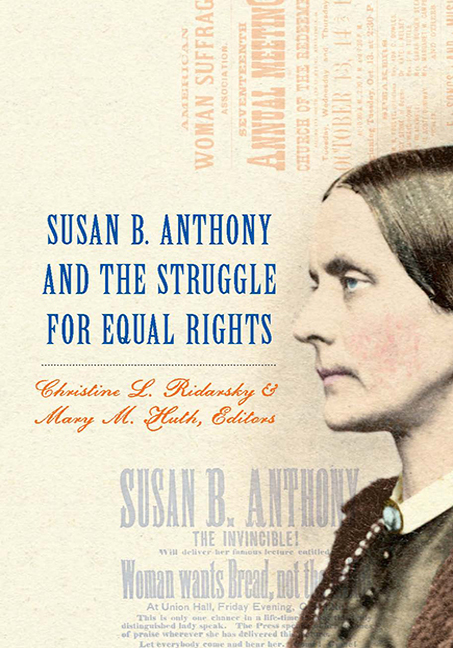Book contents
- Frontmatter
- Dedication
- Contents
- Preface
- Introduction
- Part 1 Constructing Memory
- Part 2 Anthony and Her Allies
- Chapter 2 “To Bury the Black Man and the Woman in the Citizen”: The American Equal Rights Association and the New York State Constitutional Convention of 1867
- Chapter 3 “I Pray with My Work”: Susan B. Anthony&s Religious Journey
- Part 3 Broadening the Boundaries of the Equal Rights Struggle
- Part 4 Reconstructing Memory
- List of Contributors
- Index
Chapter 2 - “To Bury the Black Man and the Woman in the Citizen”: The American Equal Rights Association and the New York State Constitutional Convention of 1867
from Part 2 - Anthony and Her Allies
Published online by Cambridge University Press: 09 May 2017
- Frontmatter
- Dedication
- Contents
- Preface
- Introduction
- Part 1 Constructing Memory
- Part 2 Anthony and Her Allies
- Chapter 2 “To Bury the Black Man and the Woman in the Citizen”: The American Equal Rights Association and the New York State Constitutional Convention of 1867
- Chapter 3 “I Pray with My Work”: Susan B. Anthony&s Religious Journey
- Part 3 Broadening the Boundaries of the Equal Rights Struggle
- Part 4 Reconstructing Memory
- List of Contributors
- Index
Summary
On May 10, 1866, a group of women and men gathered in New York City for the eleventh National Woman's Rights Convention, the first women's rights meeting since the end of the Civil War. Well over a year since emancipation and the war's end, these activists felt that the time was right to resume the agitation for gender equality they had set aside “for the duration.” Congressional action on the Fourteenth Amendment further indicated a clear need for a renewed and reorganized women's rights movement. Despite receiving a significant number of woman suffrage petitions as they drafted the amendment, Republican congressmen used the word “male” to define voters in its text, indicating their belief that voting was a gendered privilege. Responding to Congress at the May convention, Susan B. Anthony shared how deeply disappointed she was by the Republican Party's support for manhood suffrage. In her opening speech, Anthony declared that the use of the word “male” in the Constitution was “a desecration of the last will and testament of the Fathers, a violation of the spirit of republicanism, and cruel injustice to the women of this nation.” Those Republican congressmen who rejected women's right to the ballot while simultaneously claiming suffrage rights for African-American men, Anthony contended, were acting out of pure political interest and “sell[ing women's] birthright” of equality to “save from a timely death an effete political organization.” It was especially egregious for Radical Republicans, Anthony argued, to tell women that their petitions for the ballot were “untimely”: “When you propose legislation so fatal to the best interests of woman and the nation, shall we be silent till the deed is done? No! As we love republican ideas, we must resist tyranny. As we honor the position of American Senator, we must appeal from the politician to the man.” Anthony's critique of Republican congressmen, which the New York Times reported was “received with tumultuous clappings of kidded hands,” was one of the first indicators that some woman suffrage supporters were beginning to feel discontented with their ostensible allies in the Republican Party, a sentiment that would continue to grow over the next two years.
- Type
- Chapter
- Information
- Susan B. Anthony and the Struggle for Equal Rights , pp. 59 - 85Publisher: Boydell & BrewerPrint publication year: 2012



